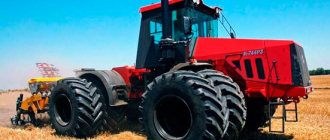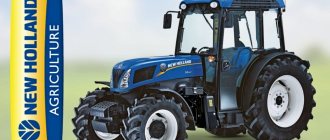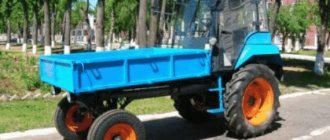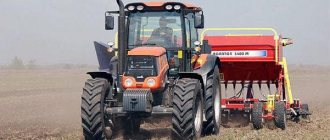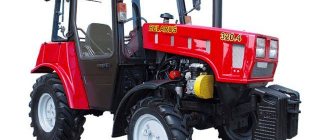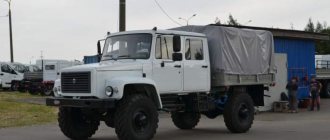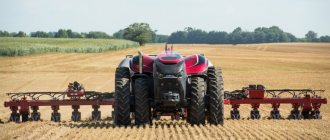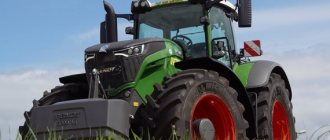TDT 40 is a caterpillar tractor developed at the Minsk Tractor Plant in 1954. The machine was constructed in literally one year and successfully passed tests. This unit is a skidder that went into production in 1956 and was produced for 15 years. Of course, the car continued to be used, since it was still relevant at that time, largely thanks to its successful design, which is distinguished by its simplicity and maintainability. Moreover, various modifications were produced at one time based on this model. TDT 40 received a large number of positive reviews. Let's consider its main advantages and operating features.
Article navigation
- 1 Purpose
- 2 Technical specifications
- 3 Features of device and operation
- 4 Photos
- 5 Videos
- 6 Price
- 7 Reviews
Purpose
TDT-40 was once one of the most promising models of the Minsk Tractor Plant, designed for a wide range of tasks. This device was positioned as a light-class caterpillar tractor. It was the compact dimensions that made it possible to operate this machine in difficult to reach areas, including off-road. The main range of tasks is the agricultural sector, as well as related activities. These are hilling, cultivation, harrowing, plowing and other methods of soil cultivation, including solid virgin soil. Support for various attachment options allows you to work in agriculture, industry, snow removal, construction and transportation operations.
Design
The Minsk-made equipment has a rather original design. The engine, a four-stroke four-cylinder, is located in the front. It is covered with a hood, and on top there is a platform for loading wood. The driving wheels are located at the rear, the cabin is above them, and the transmission occupies an intermediate position. It is above it that the winch with the worm-wheel crane is located.
All elements of the TDT-40 are attached to a frame formed by two spars - longitudinal bars. They are located transversely and connect the body and bottom into one whole. The rear axle includes turning couplings, brakes and final drive. Driven by a cardan shaft, it transmits traction force to the tracked movers.
Specifications
- Type – crawler, skidding
- Load capacity – 2500 kg
- Tractor weight – 6500 kg
- Dimensions, mm: Length – 4500, Width – 1830, Height – 2430
- Ground clearance – 540 mm
- Track width – 1480 mm
- Wheelbase – 2040 mm
- Ground pressure – 0.45 kgf/sq. cm.
- Gearbox – mechanical, with 5 forward and 1 reverse gears
- Maximum speed – 11 km/h
- Traction force – 4350 kg
- The volume of immersed wood is 6 cubic meters. m.
- Engine – diesel, D-40T, four-stroke, uncompressor
- Power – 45 horsepower
- Speed – 1500 rpm
- Starting motor – PD-10M
- ICE starting type – manual, corded.
Price
The TDT-40 has not been produced for quite some time, but this equipment can still be bought. Its cost is relatively low, since most of the copies that have survived to this day are not in very good condition.
Owners of the most “fresh” copies usually put this tractor up for sale for 100-150 thousand rubles. (if it's on the go).
Most of the TDT-40s that have survived to this day are most often sold for spare parts. That is why, having purchased equipment even in not very good condition, you can easily restore it, since almost all spare parts are sold on the secondary market.
Also, many come from similar tractors released a little later.
Features of the device and operation
- The machine has received relatively modest overall characteristics, and this is extremely convenient for working in cramped areas. After all, the machine is often used in places densely overgrown with bushes and trees. In addition, its small dimensions make it possible not only to operate the tractor in extremely difficult conditions, but also to store it in compact places. For example, such a device will fit into a small box or hangar without any problems. This will greatly simplify maintenance in harsh climatic conditions, especially when the outside temperature drops below zero degrees.
- The gearbox is a standard transmission, typical for equipment of this type. The box design includes the following components:
- checkpoint
- Clutch
- Rear axle
- Central and final drives.
Let us pay special attention to the clutch, which is a permanently closed mechanism. Its structural elements are disks (2 pcs.), drive pins, springs, casings and a heat-insulating gasket. The operation of the clutch has a standard operating principle, no different from most mechanisms of a similar type. Among the main features, we note the fact that dismantling such a clutch is possible together with the radial support bearing, since both components are structurally combined. But this drawback was not too noticeable for Soviet farmers and industrialists, who had the opportunity to quickly replace one or another unit, and without significant costs. The gearbox is bolted to the power plant crankcase. Among the features of its design, we note the following components: the primary and secondary shafts, as well as the power take-off shaft, and the shaft for the operation of the winch. The rear axle design is the largest component of the TDT-40 tractor transmission. It consists of a central gear, rotary couplings, and mechanisms that control the brakes. In addition, the rear of the axle is where the final drives are located.
- The tractor received a surprisingly unique chassis, very original compared to its counterparts from the 1950s. The chassis layout is designed in such a way as to ensure unprecedented cross-country ability on any surface. These can be muddy soils, ruts, hills, fords, deep snowdrifts and other difficult obstacles. The tracked chassis prevents slipping and slipping, and also provides good directional stability, which is very important for rollover protection. Practice has shown that the capabilities of the TDT-40 tractor chassis made it possible to successfully operate it in logging and other logging tasks associated with the transportation of large volumes of unprocessed tree trunks. So, the chassis includes a spar frame, balance spring suspension, wheels and tracks. One of the main components - the frame - consists of two channels and sheets that act as the bottom of the tractor. The reliability and strength of the frame is due to the presence of cross links made of thick metal that is resistant to corrosion and deformation. The balancer-spring suspension, in turn, includes balancers (2 pcs.) with springs, carriages (4 pcs.) and shock absorbers (4 pcs.). The wheeled chassis is made of cast steel wheels mounted in a caterpillar track. The drive wheels have special gear rims. As practice shows, such wheels often become clogged with dirt and debris, which is why they have to be cleaned regularly. This is a design feature that can be eliminated on your own. As for the tracks themselves, they are by far the most important element of the chassis and therefore the most reliable and durable. Thus, the tracks are made of high-strength steel. The track links are made of this material and are connected by floating pins.
- The power plant is quite powerful by the standards of its time. The unit with the factory designation D-40T has a four-cylinder, four-stroke design and is presented in two modifications. So, in a simplified version, the motor is turned on using a starting device, and a more advanced version has an electric starter. Both modifications should be deservedly praised for their reliability and trouble-free starting at sub-zero temperatures. Both power plants are liquid cooled, and the coolant can be antifreeze or plain water. Liquid circulation is carried out using a special water pump and a 28-liter filling tank. With a power of 45 horsepower, the engine has excellent traction characteristics. For example, the torque exceeds 20 N/m and the displacement is 4.5 liters. The engine has an all-metal housing, which is extremely resistant to corrosion. A special cooling fan is provided as an additional option. The lubrication system is forced, under the influence of an oil pump, which operates using gears located on the crankshaft.
- As for the fuel supply system, it is presented in the form of a fuel tank, from which fuel is supplied through a brass fuel line. This wire material was not used by chance, due to its corrosion resistance. In addition, the fuel supply system is complemented by a built-in filter, thanks to which you can fill in fuel with a low octane number. The pressure in the fuel system is carried out using a GPM (gear pump). Coarse and fine filters are available.
- Attachments:
- Winch
- Loading shield
- Hydraulic pipeline.
What equipment is it equipped with?
The skidding tractor is equipped with equipment that significantly simplifies the operation of the equipment:
- Photo: diagram of the winch of the skidding tractor TDT-40
- winch;
- loading shield;
- hydraulic drive
The winch housing is made of corrosion-resistant cast iron (alloyed). A driven sprocket is installed on the tail part of the worm, driven by several more mechanisms.
The worm pair, which bears most of the load during operation, operates in an oil bath. The brake mechanism that stops the rotation of the drum is controlled from the driver's cab.
The shield used to lay the trunks on it is a welded hinged frame. All beams are made of steel channels. That is why the shield can withstand a load of 5.5 tons.
The hydraulic drive includes the following components:
- oil pump;
- distributor;
- power cylinders (2 pcs.);
- expansion tank.
Do you know for the assembly of which modifications the base of the Tatra 148 car, the production of which began in 1972, was used? A review of the GAZ-33081 truck has been prepared for you.
By following this link https://spez-tech.com/tehnika/gruzovie-avto/tatra/samosval-815-dostoinstva-harakteristiki-i-raznovidnosti.html, you can familiarize yourself with the technical characteristics of the Tatra 815 dump truck.
Photo
Reviews
- Mikhail, Altai. We mercilessly operate this tractor in harsh climatic conditions. The machine is well adapted to difficult-to-reach forest areas. Due to its compact dimensions, you can quickly turn around - and this is also facilitated by excellent visibility thanks to the wide glass area. The cabin is a bit cramped, and the seat back is too short - you sit on a foam stool. The carrying capacity of this old man is such that the tractor is capable of carrying a large volume of wood at one time without breaking down. But regular maintenance is a must for this machine. It is necessary to lubricate all parts, clean the tracks from debris and dirt, touch up rusting body panels (especially in the sill area), and change consumables on time.
- Stanislav, Irkutsk. My grandfather drove around on this tractor and practiced on it some more. I only drove it a couple of times, this was in the mid-1980s. Unfortunately, even then I did not understand why my ancestor liked the car. The tractor was about 30 years old at the time and was running. Maybe this was his main advantage. I know from history that the car was in high demand in remote forest areas. I only had first impressions of the TDT-40 tractor, since I didn’t really work on it - you sit in the cab as if on a stool, and there is no comfort. I seemed to be surrounded by drafts on all sides (it was minus 20 degrees). The machine was clumsy, but had good carrying capacity and was capable of transporting a large number of logs at a time. Now I work on a KamAZ tractor. There is progress.
- Alexey, Leningrad region. My TDT-40 tractor has survived to this day and is still running. I'm selling it now, and at the same time I continue to use it. The equipment chugs along properly, and there is not a single hint of another major overhaul (the engine overhaul was done in 1990). The engine is noisy, but powerful and torquey. It is, of course, absurd and stupid to hope for comfort in the cabin - after all, the car is more than 50 years old. The tracks were completely replaced in 2005 with more advanced ones. I was glad that the cabin is warm in winter, but this is thanks to me - I installed a more powerful heater myself. I also like the excellent visibility and excellent maneuverability. In general, the car is fully functional, but you still have to sell it.
Model development history
The skidding equipment project labeled TDT-40 was created back in 1954 at MTZ (Minsk Tractor Plant).
In just one year, a model was prepared and successfully passed the tests. This skidder went into production in 1956, and its production continued for 15 years.
Over time, the model became morally obsolete, but since it was initially successful, various modifications began to be produced on its basis.
The first was the TDT-40M tractor. Its main difference from its older brother was the more powerful D-48T engine (45 hp). Otherwise, both models are almost identical.
The next round of development in this area of tractor construction is the TDT-55. This tractor is larger in size; it is equipped with a motor whose power is as much as 95 hp. With.
The weight increased by more than 1.5 times in comparison with the TDT-40. The last in this series is TDT-60. It was produced at the Altai Tractor Plant.
TDT-40 has excellent performance and technical characteristics that make this tractor still relevant today.
In some remote areas of Siberia it is still used and functions successfully. With proper maintenance and compliance with operating rules, the TDT-40 and its modifications can last for many years.
